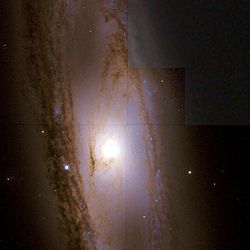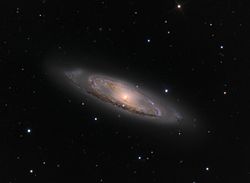| Messier 65 | |
|---|---|
 | |
| Observation data (J2000 epoch) | |
| Constellation | Leo |
| Right ascension | 11h 18m 55.9s [2] |
| Declination | +13° 05′ 32″ [2] |
| Redshift | 0.002692±0.000010 [2] |
| Heliocentric radial velocity | 807±3 km/s [2] |
| Galactocentric velocity | 723±5 km/s [2] |
| Distance | 41–42 Mly (12.57–12.88 Mpc) |
| Apparent magnitude (V) | 9.3 [3] |
| Characteristics | |
| Type | SAB(rs)a, [2] LINER [2] |
| Size | 113,500 ly (34.76 kpc) (estimated) [2] |
| Apparent size (V) | 8.709 × 2.454 moa [4] |
| Other designations | |
| NGC 3623, [2] UGC 6328, [2] PGC 34612 [2] | |
References: SIMBAD: Search M65 | |
Messier 65 (also known as NGC 3623) is an intermediate spiral galaxy about 35 million light-years away in the constellation Leo, within its highly equatorial southern half. It was discovered by Charles Messier in 1780. With M66 and NGC 3628, it forms the Leo Triplet, a small close group of galaxies.





